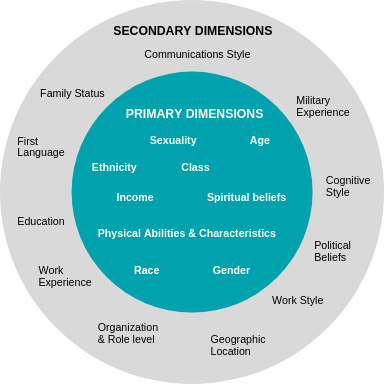1.2 The Relationship Between Diversity and Inclusion
To start the conversation, it is important to look at how the concepts of diversity and inclusion are different.
Diversity is the range of visible and invisible qualities, experiences and identities that shape who we are, how we think, and how we engage with and are perceived by the world. These can be along the dimensions of race, ethnicity, gender, sexual orientation, socio-economic status, age, physical or mental abilities, religious/spiritual beliefs or political ideologies. They can also include differences such as personality, style, capabilities and thoughts/perspectives.[1]
Inclusion is what a community, group or organization does, or how it acts to ensure that individuals feel welcomed, valued and supported as members.[2]
Dimensions of Diversity

Throughout this toolkit, we use both these terms because it is impossible to have a conversation about inclusion without also considering its relationship with diversity. The above graphic shows the primary and secondary dimensions of diversity and their intersections. One way of looking at the relationship between diversity and inclusion is to see that increasing the diversity on a board is the first step towards more inclusive governance. As Vernā Myers suggests, inclusion is the difference between being invited to the party and being asked to take a more active and engaged role, like being asked to dance.[3]. The reason to start the conversation about building inclusive governance is not to be critical about your board and its practices. If you have invested time and energy in the conversation about board diversity, the conversation about building inclusion is the next logical step. It is about how to make governance bodies more open and welcoming to difference, to ensure that everyone around the table feels like they have an equal right to be there and that all voices and perspectives are given space.
Although this may sound like a simple task, it takes time and requires the participation of everyone in your organization. This is because not everyone may feel like they have a right to be at the table and once they are there, they don’t necessarily feel like their voices hold the same value as others’ (and in some cases, our unconscious bias privileges some identities over others).
- Ontario Public Service Inclusion and Diversity Blueprint (2017). Retrieved from Ontario Public Service ↵
- Morley, T. (2018). "Making the business case for diversity and inclusion: Short case studies and research papers that demonstrate best practice in HR", Strategic HR Review, Vol. 17(1), pp.58-60. Retrieved from Emerald Insight ↵
- Cho, J.H. (May 25, 2016). "Diversity is being invited to the party; inclusion is being asked to dance," Verna Myers tells Cleveland Bar. Retrieved from Cleveland.com ↵
